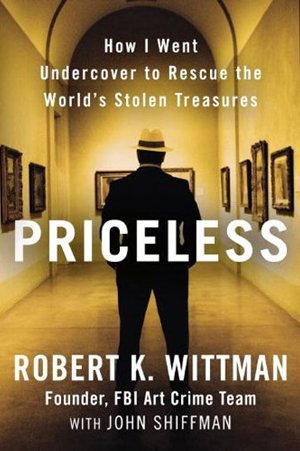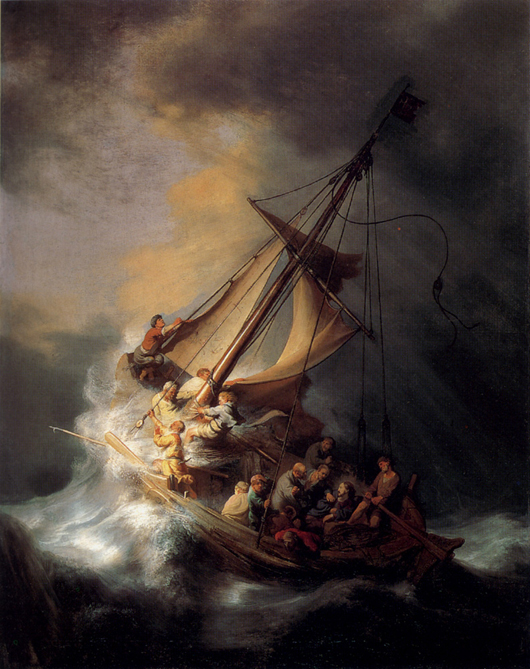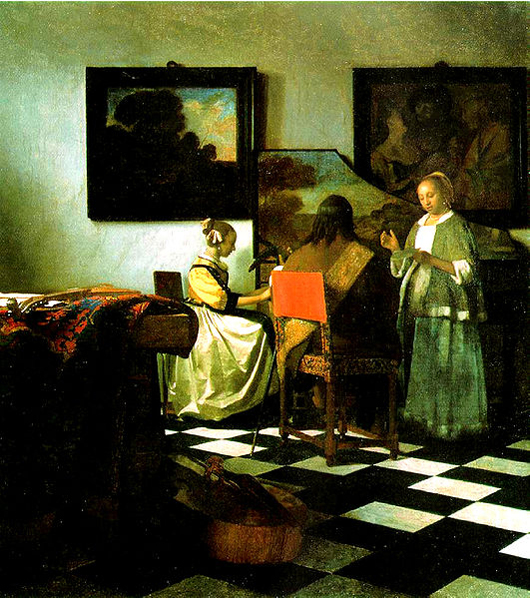
PHILADELPHIA (ACNI) – “Freeze! FBI!”
Growing up in Baltimore during the 1960s and ’70s, young Bob Wittman would wait all week to hear those heart-stopping words, his eyes locked on the no-nonsense escapades of Lt. Lewis Erskine on the TV show FBI. In that semi-fictionalized onscreen portrayal of the FBI in action, G-Men became heroes in the eyes of a generation of postwar kids, including Wittman, who would grow up to become the most famous of all international art sleuths and founder of the FBI Art Crime Team.
Wittman’s stellar 20-year career as the agent who made life a misery for criminals who brokered stolen artworks “in the space between the black and the white” is chronicled in a riveting new memoir titled Priceless – How I Went Undercover to Rescue the World’s Stolen Treasures.
As we learn from the pages of Priceless, which was authored by Wittman together with Pulitzer Prize-winning journalist John Shiffman, FBI men are not born; they’re made. In Wittman’s case, the inspiration to serve his country came from two particular role models – one the product of a screenwriter’s imagination, the other a flesh-and-blood FBI agent from Baltimore.

The neighborhood in which the Wittman family lived had its own version of Lt. Lewis Erskine, the impeccably attired TV character played by Efrem Zimbalist Jr., whose actions in the line of duty were always beyond reproach.
“One of our neighbors, Walter Gordon, was a special agent in the FBI’s Baltimore division. When I was ten years old, he was the coolest man I knew,” Wittman recalled. “Mr. Gordon wore a fine suit, shined shoes and a crisp white shirt every day. He drove the nicest car on the block, a bureau-issue late-model green two-door Buick Skylark. People looked up to him.”
While that real-life image made a potent impression, Wittman says the endorsement from his mother, Japanese-born Yachiyo Akaishi Wittman, was an important factor in molding his ambitions for the future. Mrs. Wittman, who had a keen eye for decorum, approved of the way in which FBI agents deported themselves, both on television and in real life. They earned respect, she said.
“My mother, who had experienced racism [as an Asian woman married to an American man in the post Korean War era], thought it was important to protect people from abuse, and that being an FBI agent was one of the highest-honor jobs. She was always one of my biggest fans,” Wittman said in a phone interview with Auction Central News.
After graduating from college and working briefly for his dad’s agricultural newspaper, Wittman saw an ad that said the FBI was accepting applications for new agents. Having long harbored the dream of working for the agency, Wittman applied and was accepted for a position in Philadelphia.
His initiation as a G-Man was the quintessential baptism by fire, with two major art robbery cases occurring during his first week on the job. One of the cases involved the brazen daylight theft on Nov. 23, 1988 of the sculpture The Man with the Broken Nose, from Philadelphia’s Rodin Museum. There’s a temptation to laugh as Wittman relates how he nearly froze from hours of surveillance in sub-freezing temperatures in an undercover van, not having bothered to wear a coat; and how, on that same mission, he was unable to contact his fellow agents for backup at a critical point because the van’s radio had a dead battery. Wittman’s own handheld radio was in fine working order – sitting on his desk back at headquarters.
From those early lessons, Wittman became a quick study. It didn’t take long for him to learn the ropes, sharpen his skills and start digging into major art-theft cases. Along the way, he also became educated about art and artists by taking courses at Philadelphia’s renowned Barnes Foundation. If he was going to consort with criminals and take on the persona of a dealer looking for fine art with a five-finger discount, he had to know what he was talking about.
Yet, what immediately set him apart from other FBI agents working on art cases was his understanding of how art deals are done. His father, Robert A. Wittman, had opened Wittman’s Oriental Gallery, an antique shop on Howard Street in Baltimore, after leaving the publishing world in 1986. The younger Wittman’s exposure to how antiques and art dealers ply their trade would later prove invaluable. “You can take courses,” Wittman said, “but you have to know how the business works if you’re going to make the kinds of deals that catch the criminals.”
In Priceless, Wittman writes about the skills he acquired intuitively while under the guise of his alter ego, shady American-based art dealer “Bob Clay.” The tricks of his trade include: keep the lies to a minimum, never work on your own home turf, learn the lingo of the business in which you’re operating, and always use your correct first name – it’s easier not to slip up if you do that. There’s an incident in the book in which Wittman – or shall we say, Bob Clay – has made arrangements to meet with a man named Charlie Wilhite, who wants to sell him a stolen African-American Civil War regiment battle flag. Wittman goes to Philadelphia Airport to pick up Wilhite, who has just flown in from Kansas City. While walking toward the airport exit with Wilhite, Wittman is spotted by one of his neighbors, who happens to be at the airport at precisely the same time. The neighbor waves at Wittman and calls out, “Hi, Bob!” Wittman acknowledges his neighbor with a nod and a quick hello, then calmly continues his conversation with the criminal. Had he been using a phony first name, his cover would have been blown.
On another occasion, Wittman was playing the role of an underworld diamond courier, complete with a briefcase containing $15 million in loose diamonds handcuffed to his arm. The would-be buyer of the gems – which supposedly were going to be used to finance covert operations in Europe – asked to meet with Wittman at a specific Philadelphia hotel. Wittman showed up at the appointed time, and so did the “buyer” – but Wittman immediately became suspicious when the man turned up wearing a heavy overcoat in a warm hotel lobby. Something didn’t feel right, so rather than stepping into the elevator with the man, Wittman gave an early takedown signal, and his fellow agents swooped in. When the agents frisked the man, they discovered he was packing not only a gun but also a hatchet. He had planned to kill Wittman, then cut off his arm to access the briefcase.
Priceless presents the truth – warts and all – about Wittman’s career. He reveals the details of a tragic car accident that claimed his agent-partner’s life, and the subsequent trial that might have cost him his career and put him behind bars, had he been found guilty of drunk driving. The circumstances surrounding the car accident that killed Agent Denis Bozella changed Wittman’s life and taught him lessons that would underscore the motivation for his being an FBI agent in the first place: “to do the right thing.”
Because it is a memoir, Priceless has the luxury of leaving out the chaff and cutting to the heart of the matter by condensing Wittman’s adventures to just the nail-biting thrillers that have caught the attention of Hollywood production companies. During ACN’s interview with Wittman, he confirmed that Priceless had attracted the interest of both former James Bond star Pierce Brosnan, and Leonardo di Caprio. Our own pick for the lead role, George Clooney, also appears to be on Wittman’s short list of actors he’d like to see portraying him on the big screen. There’s a similarity in their personalities and even a physical resemblance between Clooney and Wittman. [n.b. – Two days after the interview with Wittman, Variety reported that Graham King, whose past projects include The Departed and The Aviator, had sealed a deal for the motion picture rights. Wittman will serve as a consultant on the film.]
Priceless is a roller coaster ride through international cases in which Wittman was the FBI’s calculatingly brilliant but nevertheless risk-taking main man. The now-solved crimes detailed in this book are legendary in the annals of fine art recovery and the FBI.
You want adventure? You want action? Wittman had his fair share of both, jet-setting around the world and moving with the ease of a cat burglar from one group of scoundrels to the next. Among the cases included in Priceless are:
- Going undercover in Madrid to extract from a Spanish mobster Goya and Brughel paintings valued at $50 million
- Recovering the golden armor of an ancient Peruvian warrior king
- Traversing three countries, setting up wiretaps and rubbing elbows with Hollywood mobsters and a trio of punks from Iran to rescue two Renoirs and a Rembrandt worth $40 million
- Catching an appraiser con man who used PBS’s Antiques Roadshow to steal countless heirlooms from war heroes’ descendants
- Saving an original copy of the Bill of Rights that had been believed lost for a hundred years
Perfect score? Almost. There was one that got away, and it was the biggest fish of them all: the Isabella Stewart Gardner Museum case. In the early-morning hours of March 18, 1990, as the St. Patrick’s Day revelry was winding down in Boston, two men disguised as Boston police officers conned their way into the celebrated art museum, duct-taped and cuffed the two on-duty security guards to plumbing pipes, and spent the next 45 minutes grabbing one masterpiece after another from the gallery’s walls. Among them were two Rembrandt paintings – The Storm on the Sea of Galilee and Portrait of a Lady and Gentleman in Black; a Rembrandt self-portrait etching, and Vermeer’s The Concert, the most valuable of all known stolen paintings. Using box cutters, the thieves callously sliced the artworks from their frames, but clearly the perpetrators were not art experts, as they left behind a priceless Botticelli, a pair of Raphaels, a Matisse, a Whistler and a Michelangelo.

In the years to follow, hundreds of FBI agents and police officers would investigate the Gardner case, which is still considered the largest art theft in world history. Thirteen artworks were taken, with a total value estimated at $500 million.
A reward that grew to $5 million enticed a motley cast of characters to try their hand at recovering the stolen art, as well. Aspiring gumshoes, investigative journalists, even members of the mob gave it a shot, but to not avail.
It was not until 2006 that a credible tip came to the FBI and landed on the desk of the man best suited to following up on it – the founder of the agency’s Art Crime Team: Robert Wittman. It was the lead Wittman needed to revive the investigation, and it might have led to the crowning achievement of his career, but as his memoir reveals, he would get to the brink of his goal… and no further.

It is a bitter irony that law enforcement agencies, themselves, were responsible for bungling the set-up that quite likely would have resulted in the recovery of artworks stolen from the Gardner Museum. It seems that every law-enforcement agency concerned with the case, including those that were only peripherally involved because a perp had passed through their jurisdiction, wanted the credit if and when the case was cracked. Even competing branch offices of the FBI jumped into the fray, staking a pre-emptive claim. Each agency wanted the arrest either to take place on their soil or with their cops in charge, for the whole world to see. Because of the posturing and squabbles between agencies, the sting operation Wittman had worked so diligently and skillfully to orchestrate never transpired. It’s agonizing to read Wittman’s account of a botched operation caused by too many cooks in the kitchen.
“In my opinion, we were two weeks away from recovering the Rembrandt and the Vermeer. I believe [the go-betweens we were dealing with] did have access to them,” Wittman said.
Will the Gardner Museum case ever be solved and the artworks returned to Boston, now that the architects of the crime realize the FBI was about to nail them? Wittman says ‘yes.’
“In my heart of hearts I think the paintings can be recovered. The best news coming out of this is that the artworks were not destroyed. I think the Rembrandts and Vermeer are still in existence. It would be a ‘win’ of epic proportions to get them back someday.”
Hopefully that will happen, but unfortunately it won’t be with Wittman’s boots on the ground or his face in the spotlight. He has retired from the FBI and established Robert Wittman Inc., an international art security firm that works with institutions, insurance companies and individuals to track down stolen artworks and advise them on how to secure their collections.
Wittman is also currently a hot property on the lecture circuit. To find out where he will be speaking next, or to learn more about Wittman’s security firm, visit Wittman’s Web site at www.robertwittmaninc.com.
But before you do anything else, get this book. It’s the real deal.
Copyright 2010 Auction Central News International. All rights reserved. This material may not be published, broadcast, rewritten, or redistributed.
# # #

